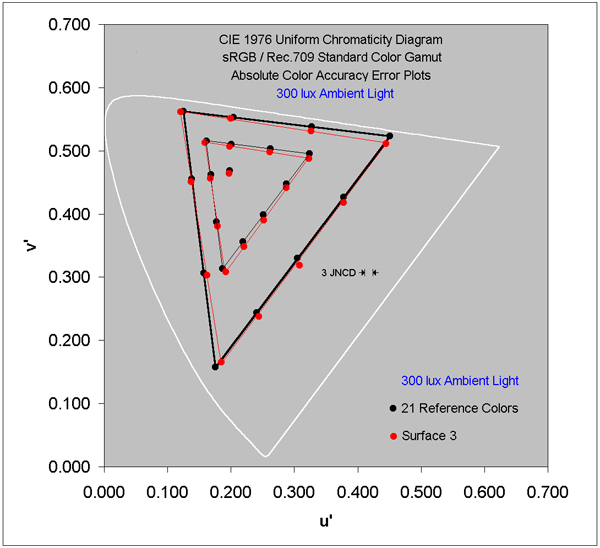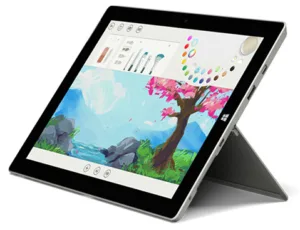Display Daily’s friend, Ray Soneira of DisplayMate, has been busy, with a review of Samsung’s SUHD (Samsung Flagship LCD TV Stumbles on Viewing Angle) and LG’s OLED TVs last week, and a review of the Microsoft Surface 3 tablet this week.
Soneira has been testing mobile devices since 2006, so he has seen a lot of changes and he has been very critical of the performance of mobile devices in higher levels of ambient lighting. But, in the case of the Microsoft tablet, he is pleased to report that the display is “the first display that has a Color Gamut optimized for typical 300 lux indoor ambient light levels instead of for the dark”. That puts the Surface 3 into the top group of tablets that he has reviewed and, in that aspect, better than the Surface Pro 3, which has a bigger display, at 12″, compared to 10.8″, with 1920 x 1280 format.
Although the resolution is lower than some other tablets (and the Surface Pro 3), Microsoft’s use of its ClearType technology (also in desktop Windows) makes the text sharper than “almost all other tablets”.
Colour accuracy is exemplary, with full sRGB/Rec 709 coverage in darkness and with JNDs of just 2.2, the display is among the best that Soneira has ever measured on a mobile device. Unusually, the display maintains the full gamut coverage in 300 lux of light and with JNDs of 1.7 making the Surface 3 “more accurate than any other display that we have ever measured in real world ambient lighting conditions at 300 lux”. The accuracy of the colours might make images seem a little more “subdued” than the inflated colours of some displays, Soneira said, but he liked them!
 DisplayMate found the Surface colour accuracy to be “Excellent”, even in 300 lux of ambient light
DisplayMate found the Surface colour accuracy to be “Excellent”, even in 300 lux of ambient light
Brightness is less than other full size tablets like the Apple iPad Air 2, at 395cd/m². Some medium sized tablets are notably brighter. Screen reflections are 6.0%, which Soneira rates as “Very Good” and in the middle of the range of better tablets. Colour performance from the IPS/PLS LCD is good at wide viewing angles, but, as with all LCDs, brightness falls off sharply away from the perpendicular axis.
Finally, the power consumption was checked and DisplayMate found that an Apple iPad Air 2 of the same size would use 76% more power than the Microsoft display, aided by the lower resolution of the LCD.
In conclusion, Soneira said that the display ties for first place with the Surface Pro 3 and Samsung Galaxy Tab S 10.5 for colour accuracy and is the best in high brightness. He identifies as a step towards a new generation of displays that work well in real world conditions by adjusting the gamut as well as the brightness to optimise accuracy at all times.
The full review is available here.
Analyst Comment
The Microsoft Surface tablets are, without doubt, very strong examples of Microsoft’s hardware capabilities. It would need high quality to allow Microsoft to get HP and Dell (and Accenture) to re-sell the products into corporates, a deal that was announced a couple of weeks ago. Apple has deals with IBM and Cisco, and some commentators have suggest that the common theme for HP/Dell and Microsoft is the fear of Apple.
Soneira has been very consistent in his campaign to improve display performance in high ambient, by improving both the displays and the algorithms used to control them in different lighting conditions. (BR)

